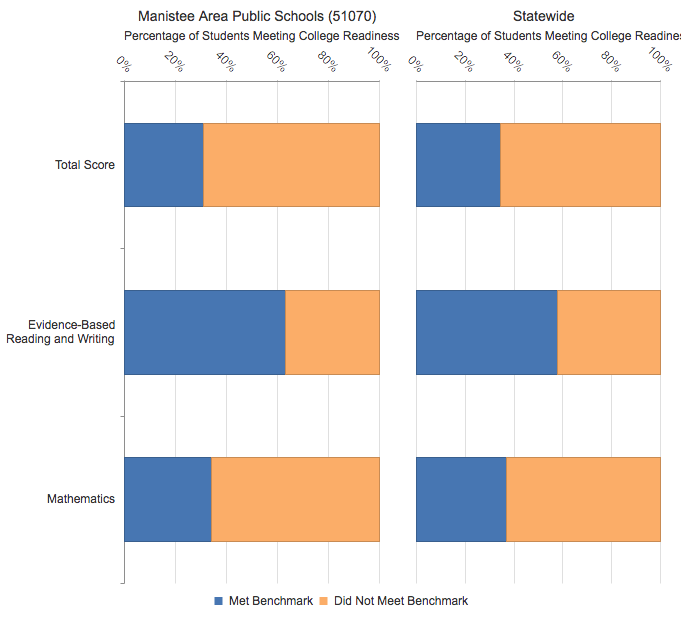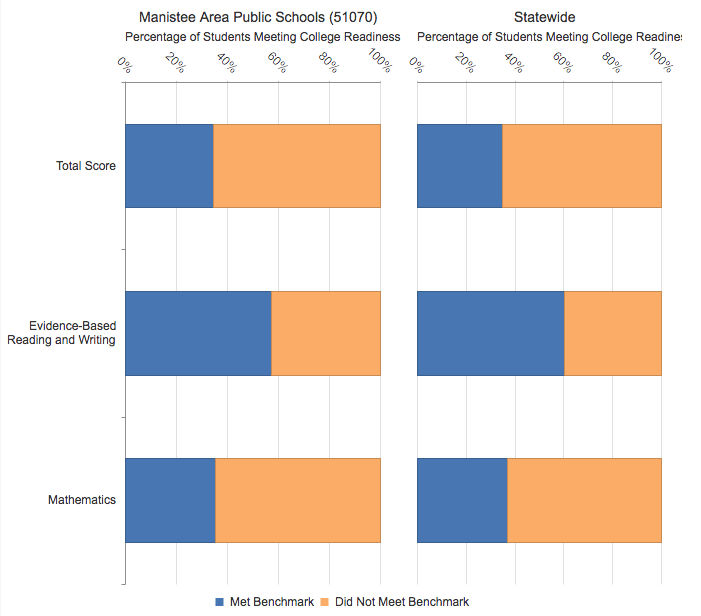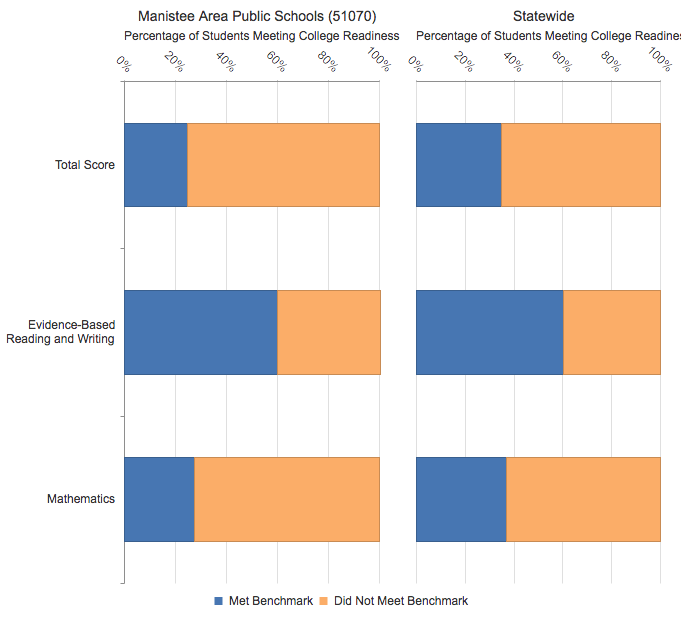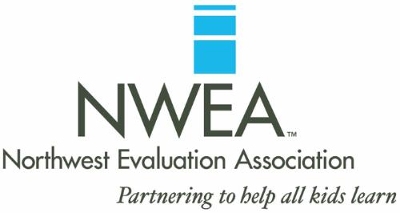
Northwest Evaluation Association
NWEA® is a research-based, not-for-profit organization that supports students and educators worldwide by creating assessment solutions that precisely measure growth and proficiency—and provide insights to help tailor instruction. For 40 years, NWEA has developed Pre-K–12 assessments and professional learning offerings to help advance all students along their optimal learning paths. Our tools are trusted by educators in 145 countries and more than half the schools in the US.
Section 1 - NWEA Overview
NWEA Overview (printable link)
Each year, our students, will continue their Chippewa Journey by participating in the Northwest Evaluation Association Measures of Academic Progress® (NWEA MAP) assessment in the Fall, Winter, and Spring. These tests assist us in determining your child’s instructional level and measure his/her academic growth throughout the school year and from year to year in the areas of Math, Reading, and Language Usage. Here are the tests that our students take: MAP tests are unique in that they are adaptive tests your child takes on a computer. This means that the test becomes more difficult the more questions your child answers correctly. When your child incorrectly answers a question, the test becomes easier. Therefore, each test is specifically created for a student’s level.
MAP tests are unique in that they are adaptive tests your child takes on a computer. This means that the test becomes more difficult the more questions your child answers correctly. When your child incorrectly answers a question, the test becomes easier. Therefore, each test is specifically created for a student’s level.
The percentile indicates where the student scored in relation to all other students (not just within his/her school or in the District) who have taken the NWEA MAP assessment at his/her grade level during the same testing window.
The RIT score is an equal-interval scale, like feet and inches, that is independent of grade level. As a result, we can easily measure growth in learning. This type of score increases the value of the tests as a tool to improve student learning because it enables teachers to recognize where to focus attention for your child’s learning.
Your child’s MAP results are reported in RIT (Rasch unIT) scores and percentiles. These are different types of scores than a typical test that provides a percentage correct. The MAP assessment is fully comprised of Common Core State Standards aligned questions. We will be able to gather comparison data with previous assessments and help us in our work as we continue to march towards personal excellence.
Understanding the RIT Score The charts provided show the national median RIT scores for grades 1-8 in a typical school district. You may use these charts to help determine if your student is performing at, above, or below grade level compared to students across the nation. It is important to understand that the MAP test is one test at one point in time. It does not measure intelligence or a student’s capacity for learning. When making important decisions about students, school staff will consider the MAP test results along with other data such as classroom performance, other test scores, and input from parents and teachers.
Growth Over Time We expect RIT scores to increase over time. Typically, younger students show more growth in one year than older students. Students who test above grade level often show less growth. Sometimes RIT scores may decline from one test to the next. One low test score is not cause for immediate concern. Like adults, students have good and bad days and their test results do not always indicate what they know. Students’ attitudes toward the test can also affect their score, along with the Summer Slide. The Summer Slide is referred to as “summer learning loss.” On average, students lose academic ground during the summer. Therefore, growth over time is a better measure of student learning. Anticipated growth rates for each student are based on national norms and should be viewed as “typical” growth, not expected growth. Our goal is for teachers to use the data to differentiate and adjust instruction so that all students grow at levels appropriate for each individual.
Check out the NWEA Parent Toolkit @ www.nwea.org/parent-toolkit/
NWEA RIT Score Charts
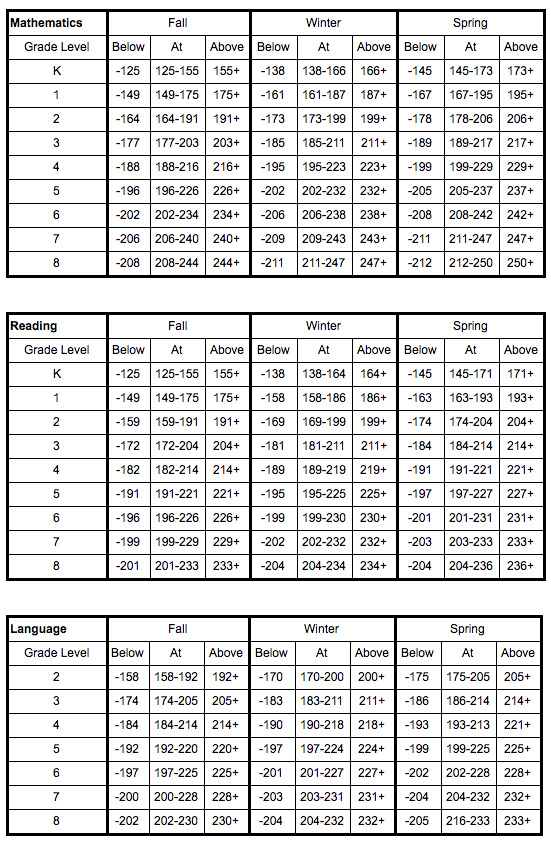
The norms in the tables below have a very straightforward interpretation. For example, in the status norms for reading, grade 2 students in the middle of the “begin-year” period had a mean score of 174.7 and a standard deviation of 15.5. To get a sense of how much dispersion there was, the SD 15.5 can be subtracted from the mean and added to the mean to produce a range of about 159–190. Since the norms are based on the bell curve, we know that 68% of all scores are expected to fall between in this range.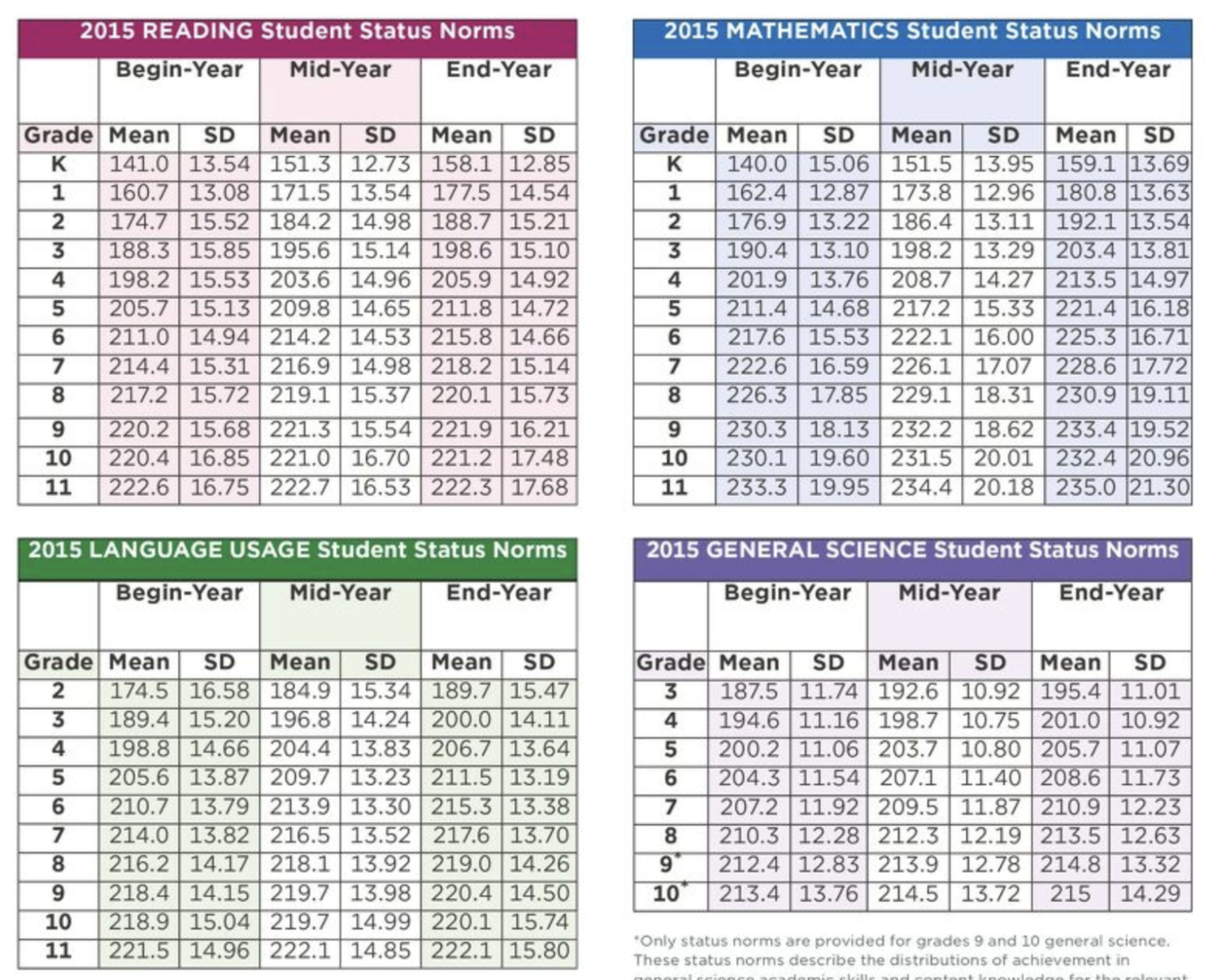
Section 2 - Protocols
- K – 3rd: Overview and test results sent home at end of testing window, spend time with reports at Fall Parent Teacher Conferences
- 4th – 8th: Overview and test results sent home at end of testing window, bring if questions to Fall Parent Teacher Conferences
- Teachers will attempt to avoid large assessments (tests, projects, reports, or other time intensive assignments) during the NWEA testing window
Section 3 - Sample Report
Section 4 - District Summary Reports
Section 5a - NWEA Overall Performance Graphs 2017-2018 - Kindergarten through Second Grade
Section 5b - NWEA Overall Performance Graphs 2017-2018 - Third through Fifth Grade
Section 5c - NWEA Overall Performance Graphs 2017-2018 - Sixth through Eighth Grade
Section 6 - NWEA Student Growth Summary Graphs 2017-2018
Section 7a - NWEA Overall Performance Graphs 2018-2019- Kindergarten through Second Grade
Section 7b - NWEA Overall Performance Graphs 2018-2019 - Third through Fifth Grade
Section 7c - NWEA Overall Performance Graphs 2018-2019 - Sixth through Eighth Grade
Section 8 - NWEA Student Growth Summary Graphs 2018-2019
Section 9 - Student Practice Links
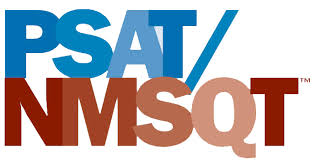
PSAT
The Preliminary SAT, also known as the PSAT/NMSQT® (National Merit Scholarship Qualifying Test), is a practice version of the SAT exam. Students can take the PSAT once per year, and many students take the test in both 10th and 11th grade. A high score earned on the PSAT in the junior year, could qualify the student to receive a National Merit Scholarship—$180 million dollars in merit scholarships are awarded to students each year. The PSAT is 2 hours and 45 minutes long and tests skills in reading, writing, and math. Unlike the SAT, the highest score possible on the PSAT is 1520.
Section 1 - PSAT/SAT Overview
PSAT/SAT Program Overview (printable link)
As our students progress on their Chippewa Journey at MMHS they will take the College Board Suite of Assessments, an integrated system of tests that measure what they are learning in class and what they need to succeed in college. The culminating assessment for students is the Scholastic Aptitude Test (SAT) which is taken in the spring of their junior year as part of the Michigan Merit Exam (MME). The Pre-Scholastic Aptitude Test (PSAT) is a series of tests that predicts college readiness and success on the SAT. There are actually three different PSAT exams:
PSAT 8/9- sets readiness baseline and taken in 8th and 9th grades
PSAT 10 – allow check-in on student progress and taken in 10th grade
PSAT/NMSQT – National Merit Scholarship Qualifying Test; students take in the fall of 11th grade and may qualify for the National Merit Scholarship Program
SAT – taken in the spring of 11th grade, scores are reported directly to colleges
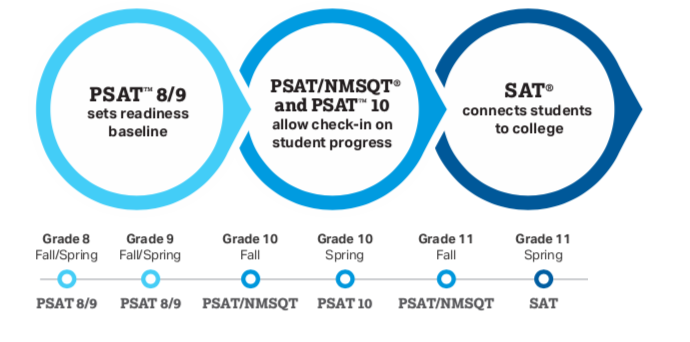
After each test students will receive a clear and detailed report on their scores and performance percentiles in each area of the test. Please visit www.collegeboard.org for more information.
Student Support In 8th grade students create a Khan Academy account giving them access to practice tests/questions, video tutorials, and both test taking and studying strategies. Visit www.khanacademy.org/sat for more information. Practice tests may also be downloaded under Section 5 below.
Parent Support Check out the For Parents section on the bottom of the Khan Academy website above.
Section 2 - Protocols
- PSAT/SAT Overview and PSAT Testing Schedules sent home before tests
- Results letter and scores (from College Board) sent home upon arrival of scores
- SAT scores are reported online
Section 3 - Sample Reports
Section 4a - PSAT Benchmark Performance 2017-2018 - Eighth Grade
Section 4b - PSAT Benchmark Performance 2017-2018 - Ninth Grade
Section 4c - PSAT/NMSQT Benchmark Performance 2017-2018 - Tenth Grade
Section 5a - PSAT Benchmark Performance 2018-2019 - Eighth Grade
Section 5b - PSAT Benchmark Performance 2018-2019 - Ninth Grade
Section 5c - PSAT/NMSQT Benchmark Performance 2018-2019 - Tenth Grade
Section 6 - Student Practice Tests
Section 7 - Student Practice Links

MME
The Michigan Merit Examination (MME) assesses students in grade 11 and eligible students in grade 12 based on Michigan high school standards. It is administered each spring, and consists of three components:
- College Board SAT
- WorkKeys® job skills assessments in reading, mathematics, and “locating information”
- M-STEP Science and Social Studies
Section 1 - MME Overview
The Michigan Merit Examination (MME) includes three components: the SAT college readiness assessment, ACT WorkKeys work skills assessment, and the Michigan Student Test of Educational Performance (M-STEP) in science, and social studies. These three components provide a measure of individual performance based on Michigan’s high school content standards as well as college and career readiness. This test is administered in early April.
- The SAT is a college admission exam that measures the skills and knowledge that research shows students need to be successful in college and careers, and reflects what students are learning in their classrooms daily. The SAT includes Reading and Writing, Language and Math tests, and an essay. The vast majority of colleges and universities in the U.S. use the SAT as an important part of the admission process. Detailed SAT with Essay results are reported in the College Board reporting portal.
- ACT WorkKeys is a job skills assessment system measuring real-world skills, designed to support economic and workforce development programs. The MME ACT WorkKeys components assess Reading for Information, Applied Mathematics, and Locating Information. Skills assessed by ACT WorkKeys are valued by Michigan employers, colleges, and technical training institutions. Students who receive qualifying scores on the three ACT WorkKeys assessments taken as part of the MME are eligible for the National Career Readiness Certificate (NCRC) and in some cases college credit. For more information, visit ACT WorkKeys.
- M-STEP assessments measure what students know and are able to do compared to Michigan’s state standards established for high school students. Science and social studies are assessed by M-STEP. For more information on the M-STEP please visit M-STEP.
MI-Access is Michigan’s alternate assessment system, and is designed for students who have, or function as if they have, significant cognitive impairments, and whose IEP (Individualized Educational Program) Team has determined that General Assessments, even with accommodations, are not appropriate. MI-Access satisfies the federal requirement that all students with disabilities be assessed at the state level.
Testing Schedule
Each year students and parents will be provided a schedule for all testing and retesting days at MHS. All protocols and requirements for testing will be previewed and shared ahead of time.
Additional College Entrance Testing
- The SAT taken during the MME window is provided by Manistee Area Public Schools; any additional testing is to be arranged by the student and at their expense. Additional testing sites and schedules
- Students wishing to take the ACT should visit ACT.org
Section 2 - Protocols
- Preview testings requirements, protocols, best testing practices, and schedule with students ahead of testing dates.
- SAT scores are reported online and directly to the colleges selected by student.
- WorkKeys and M-STEP results are reported on paper, sent to schools and distributed to students.
Section 3 - Sample Reports
Section 4a - SAT Benchmark Performance
Section 4b - M-STEP Performance Levels
Section 4c - ACT WorkKeys Performance Levels
Section 5 - Parent/Student Resources
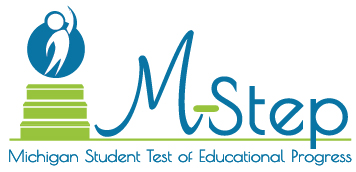
M-STEP
The M-STEP is a 21st Century online test given for the first time in the Spring of 2015. It is designed to gauge how well students are mastering state standards. These standards, developed for educators by educators, broadly outline what students should know and be able to do in order to be prepared to enter the workplace, career education training, and college. M-STEP results, when combined with classroom work, report cards, local district assessments and other tools, offer a comprehensive view of student progress and achievement. For additional information, click State Assessment in Michigan: What it is, What it means – And What it Offers
Section 1 - M-STEP Overview
M-STEP Overview (printable link)
M-STEP Overview
M-STEP (Michigan Student Test of Educational Progress) Overview
Each spring, all students take a high-quality state assessment. M-STEP is given to elementary, middle and high school students each spring.
The M-STEP is a 21st Century online test designed to gauge how well students are mastering state standards. These standards broadly outline what students should know and be able to do in order to be prepared to enter the workplace, career education training, and college. M-STEP results, when combined with classroom work, report cards, local district assessments and other tools, offer a comprehensive view of student progress and achievement.
The M-STEP shows an important snapshot of achievement at the student, building, district and state level. The snapshot provides valuable information for teachers to use to align classroom instruction and lesson plans with state standards. Schools receive a printed report they give to parents and guardians that describes their student’s performance on the subjects tested by M-STEP and MME, which differ by grade. Results are shared with families in the fall of the following school year.
Subjects are assessed by the following grade level schedule:
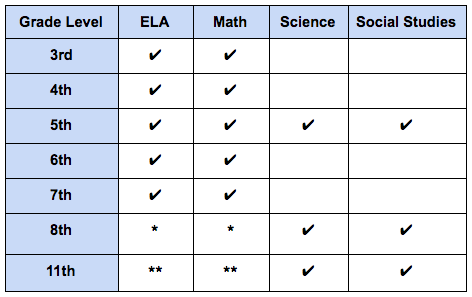
* Assessed by PSAT
** Assessed by SAT
Section 2 - Protocols
- Preview testing requirements, protocols, best testing practices, and schedule with students and parents ahead of testing dates.
- M-STEP scores by school are reported online through mischooldata.
- A paper copy of Individual student scores are sent home in the fall
Section 3 - Sample Reports
Section 4a - M-STEP Performance Level Graphs 2017-18 - Third through Fifth Grade
Section 4b - M-STEP Performance Level Graphs 2017-18 - Sixth through Eighth Grade
Section 5a - M-STEP Performance Level Graphs 2018-19 - Third through Fifth Grade
Section 5b - M-STEP Performance Level Graphs 2018-19 - Sixth through Eighth Grade
Section 6 - Parent/Student Resources
M-STEP Parent Report Video
To support teachers, parents, and student throughout the transition to higher expectations for all students, a newly developed video is now available which summarizes the M-STEP and walks viewers through how to read and interpret student scores within the M-STEP Parent Report. The video is available with or without Closed Caption at https://www.youtube.com/watch?v=qzmgtB4YAnw
M-STEP Sample Item Sets
The Office of Standards and Assessment (OSA) has created online Sample Item Sets for the current year’s M-STEP for students in grades 3-8. Sample Item Sets are a selected group of test items in English language arts (ELA), mathematics, science, and social students that encompass different item types, such as multiple choice, constructed response, and various kinds of technology-enhanced items. https://wbte.drcedirect.com/MI/portals/mi
The Office of Standards and Assessment (OSA) has posted the Guide to State Assessments.
The current Testing Schedule for Online and Paper/Pencil Assessments has been combined with this document so you can find the online test windows, paper/pencil dates, and test timing\information in one place. The guide can be found on the M-Step web page www.michigan.gov/mstep or any of the assessment web pages under the What’s New section.


